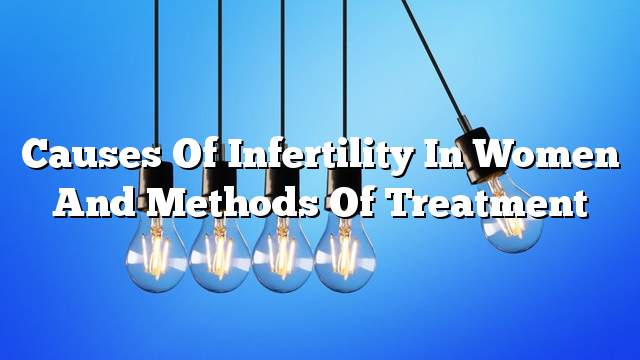Infertility in women
The causes of infertility are not limited to women only. 35% of the causes are due to women. Women share men in 25% of the reasons (ie common causes between men and women) and to know the reasons we must remember and imagine the anatomy of women.
the reasons
There are the vagina and then the cervix and then the uterus and then the fallopian tubes (or uterine canal) and then the left and right ovaries. In each of these places there is one or more reasons for not being able to have children but for lack of time we have to mention only the important and common reasons and how to address them briefly.
Let’s start with the ovary. There is often an imbalance in ovarian function. This is due either to a failure or a decline in the function of the ovary. This is a result of congenital defects in genes, chromosomes, exposure to radiation, chemotherapy or viruses such as mumps.
The other imbalance in the function of the ovaries is known as polycystic ovary and this is one of the most common or common causes, it is very common, especially in our country or in the region in general, about 20% of women suffer from it, if examined on the ultrasound device 100 Lady is about 20 women with PCOS and about half of this rate are without symptoms.
Symptoms
The symptoms in this disorder are: disorder and irregular menstrual cycle and disorder in the process of ovulation. Often the cycle comes every two or three months or sometimes comes only with the help of medicines as it is apparent, all this affects the ability to have children. Often accompanied by blisters or pills in the face and increased growth of hair in the face and abdomen and chest, all due to the high proportion of male hormone ((Testosterone.
Diagnosis of polycystic ovaries is easy to detect through vaginal ultrasound. We find that there are very small cysts (about 8 mm) on the ovaries. There is also an imbalance in the secretion of FSH and LH hormone.
the cure
The method of treatment depends on the desire of the patient, do you want to give birth or want to address the other associated problems such as disorder course and this is treated by hormones either increase the proportion of hair, this is treated by hormones or the doctor of beauty. But if she wants to have children, this is induced ovulation by drugs either pills or hormonal needles.
One of the other options is through the endoscopy where the kite or holes are made on the ovaries. There are some who criticize this method because the results are not guaranteed and you need an experienced specialist so that you do not get an overdose on the ovary affecting the ovaries. If these options do not work, there is an entry into the IVF program.
other reasons
We need to talk here about the causes of Fallopian tubes. We need to know here how pregnancy is done or the mechanism of pregnancy. The ovum simply comes out of the ovary and is picked up by the fallopian tubes. This egg continues to meet the sperm in the last part of the channel. If this egg is fertilized, the egg is fertilized and then descends into the uterus where it is grown and the pregnancy begins. Any problem in the channel such as blockage of this channel or the occurrence of adhesions around it, this leads to disruption in the capture of the egg by the fallopian tube or in the movement of fertilized egg inside the uterus tube is not pregnancy.
The cause of this is due to an old surgical procedure or failure to treat acute or chronic pelvic inflammatory diseases
Symptoms: There are no symptoms but no pregnancy.
the cure: If the adhesions are simple, they can be treated surgically by the endoscopy. If the adhesions are many and thick and if the tubes are blocked, we can only subject the patient to fertilization programs outside the body.
Endometriosis disease
A common disease is the appearance of endometrial tissue in areas outside the uterine cavity because this is unknown.
Symptoms: Sometimes there is no chance of finding a coincidence when performing laparoscopy for other reasons or pain in the lower abdomen during the menstrual cycle or the presence of tumors and often on the ovaries.
Diagnosis: The best diagnostic tool is laparoscopy.
the cure: Three options: either medically by medication, or by laparoscopy where the lining of the uterus is located in abnormal areas or surgically.
